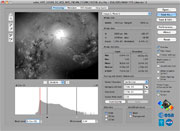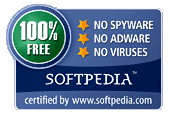The ESA/ESO/NASA FITS Liberator 3
 |
|
The logo for the ESA/ESO/NASA FITS Liberator
|
|
A screenshot of the ESA/ESO/NASA FITS Liberator v3.0. |
|
24.04.2019 MacOS 10.11 & Later
If you would like to hide the lib folder from the Finder (to prevent accidental deletion), you can open the Terminal app and issue the following command:
Note that this must be repeated for each user account on the computer that is using FITS Liberator, since the files can no longer reside at a supported system-level directory. It is also possible to disable the “rootless” mode, allowing admin access to the /usr/lib directory and enabling FITS Liberator to run on any account on the computer, but this is a technically involved process and could compromise system security, so should only be attempted by experienced users. 21.02.2012: The ESA/ESO/NASA FITS Liberator v3.0.1 has been released today. Download. |
The release of version 3 of the popular ESA/ESO/NASA FITS Liberator image processing software has meant that it is even easier and faster to create colour images using raw observations from a range of telescopes, including the NASA/ESA Hubble Space Telescope, NASA’s Spitzer Space Telescope, ESO’s Very Large Telescope and ESA’s XMM-Newton Telescope.
As with the previous versions of the FITS Liberator, the version 3 makes another leap towards making the creation of colour images from raw astronomical observations easier and faster. The FITS Liberator continues to support the FITS and PDS formats, preferred by astronomers and planetary scientists respectively, which enables data to be processed from a wide range of telescopes and planetary probes, including ESO’s Very Large Telescope, the NASA/ESA Hubble Space Telescope, NASA’s Spitzer Space Telescope, ESA’s XMM–Newton Telescope and Cassini–Huygens or Mars Reconnaissance Orbiter.
The new FITS Liberator incorporates a faster and more streamlined workflow. The CPU-intensive calculations have been optimised, thanks to significantly improved memory management, and this allows for time savings of up to 35%. For large images the savings in efficiency are even more pronounced, also thanks to a delayed application of stretch functions.
To sustain the future development of the software the entire source code, consisting of nearly 30 000 lines of code is being released as open source, and anyone wishing to contribute to future versions of the programme may do so.
Version 3.0 of the FITS Liberator include the following new features:
- FITS Liberator is now a stand-alone application, which means that Photoshop is no longer required.
- Processing medium-sized images is now up to 35% faster, thanks to significantly improved memory management.
- Processing large images are also faster thanks to delayed application of stretch functions.
- FITS Liberator saves TIFF files that open in virtually any image processing software.
- Open-source code base available on http://code.google.com/p/fitsliberator.
Get more information about the FITS Liberator on this podcast from Adobe.
Requirements
Minimum requirements:
- Windows PC (XP, Vista or Windows 7, all 32 or 64 bit) or Mac (OS X 10.5+)
- Screen resolution of 1024 x 768 pixels or better
Other limitations:
- As the loading process is very I/O intensive, the performance may be decreased significantly when loading FITS files from a network drive. In this case the program will show a notification. It is recommended, if possible, to copy files to the local hard disk drive before opening them with the FITS Liberator.
See full release notes.
The team
The team that produced the ESA/ESO/NASA FITS Liberator consists of:
Project Executive: Lars Lindberg Christensen (lars@eso.org)
Technical Project Manager: Lars Holm Nielsen
Developers: Kaspar K. Nielsen & Teis Johansen
Scientific, technical support and testing: Robert Hurt & David de Martin.
Further information
For further information on the FITS Liberator, read the PDF article "The ESA/ESO/NASA FITS Liberator 3: Have your say on new features" published on the Communicating Astronomy with the Public 2007 conference proceedings
Acknowledgements
FITS is an abbreviation for Flexible Image Transport System and has been a standard since 1982 and is recognized by the International Astronomical Union.
The ESA/ESO/NASA FITS Liberator uses NASA’s CFITSIO library, libtiff, TinyXML, Boost C++ Libraries, Object Access Library and Intel Threading Building Blocks.
Adobe and Photoshop are either registered trademarks or trademarks of Adobe Systems Incorporated in the United States and/or other countries.
We kindly ask users to acknowledge the use of this plug-in in publicly accessible products (web, articles, books etc.) with the following statement: "This image was created with the help of the ESA/ESO/NASA FITS Liberator".

